For those with busy lives, gardening can be tough. But, low-maintenance gardening is a great solution. It lets you enjoy gardening without spending too much time or effort. With simple gardening tips, busy people can make their outdoor space beautiful and stress-free.
Low-maintenance gardening is great for those with little time. It’s been shown to lower stress and boost mental health. So, busy gardeners can have a lovely garden without feeling overwhelmed.
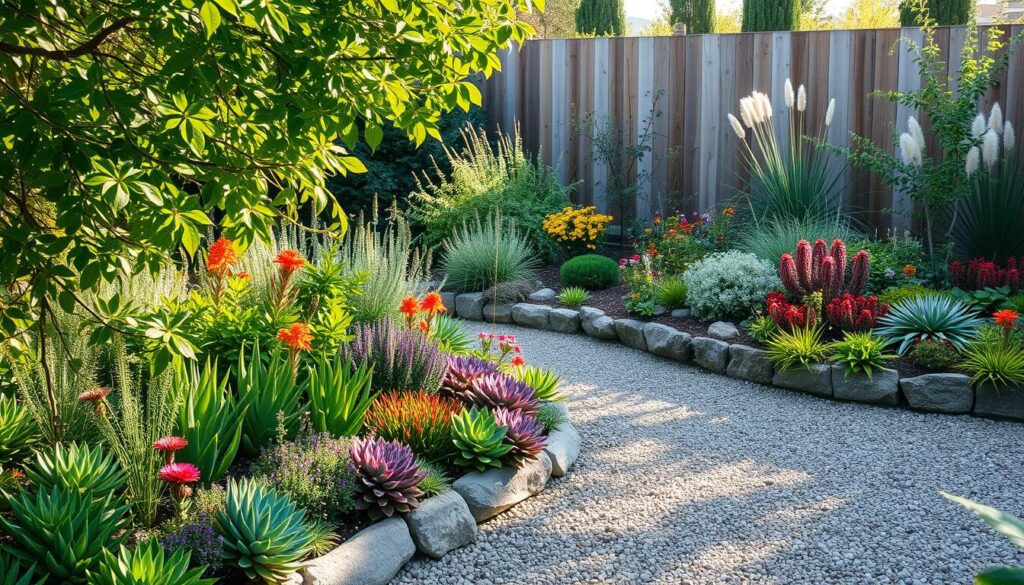
Introduction to Easy Gardening
Low-maintenance gardening is ideal for those who want a beautiful garden but don’t have much time. By picking the right plants and using simple gardening methods, busy gardeners can have a stunning outdoor area. It’s all about smart planning and choosing the right plants.
Key Takeaways
- Low-maintenance gardening saves time and reduces stress for busy gardeners
- Easy gardening techniques can help create a beautiful outdoor space with minimal effort
- Low-maintenance gardening is perfect for busy individuals who want to enjoy the benefits of gardening
- Smart garden planning is essential for creating a low-maintenance garden
- Choosing the right plants is crucial for easy gardening
- Low-maintenance gardening can improve mental health and reduce stress
Understanding Low-Maintenance Gardening Principles
Creating a beautiful garden starts with smart garden planning. You need to think about what your plants need and what you want from your garden. This careful planning helps make a garden that looks great and is easy to care for.
A well-thought-out garden saves time and effort. It uses plants that don’t need much water and smart watering systems. Knowing how to make a garden low-maintenance means you can enjoy its beauty without a lot of work.
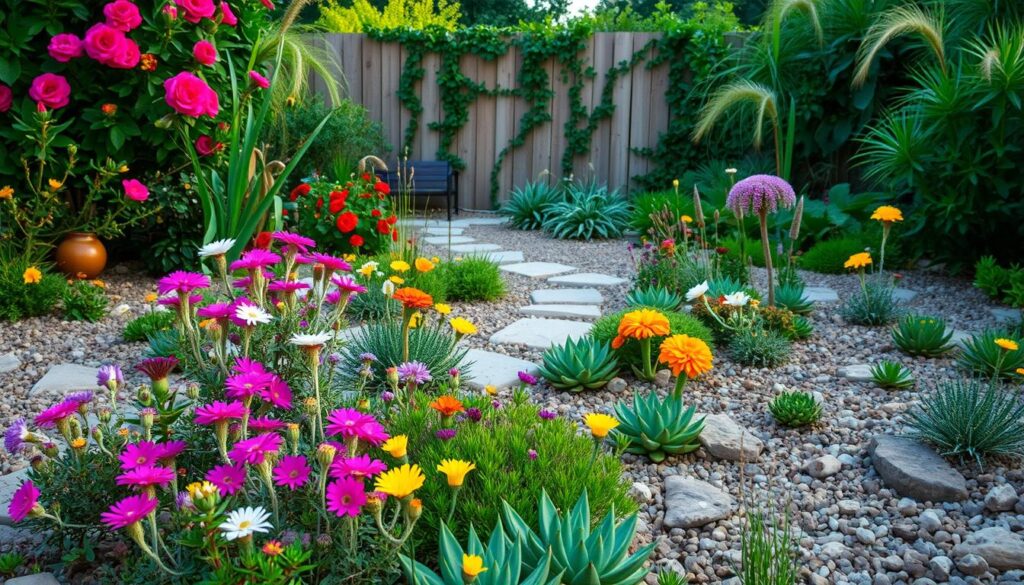
- Reduced water consumption
- Minimized need for pesticides and fertilizers
- Increased efficiency in terms of time and effort
By setting realistic garden expectations and using low-maintenance principles, you can have a stunning garden that’s simple to keep up. This way, you can enjoy your garden without too much hassle.
| Low-Maintenance Principle | Benefit |
|---|---|
| Drought-resistant plants | Reduced water consumption |
| Efficient watering systems | Minimized water waste |
| Minimal use of pesticides and fertilizers | Healthier environment |
Choosing the Right Location for Your Garden
When it comes to low-maintenance gardening, the garden location is key. Things like sunlight requirements and soil quality affect how much work your garden needs. To make a garden that’s easy to care for, you need to think about these factors.
A great garden location gets the right sunlight for your plants. Most plants need at least 6 hours of direct sunlight a day. Some can handle partial shade. Knowing what your plants need helps you pick the best spot.
Here are some important things to think about when picking a garden location:
- Soil quality: Find soil that drains well and has the right pH for your plants.
- Accessibility: Pick a spot that’s easy to get to for upkeep.
- Microclimate: Think about the local weather, including wind and frost.
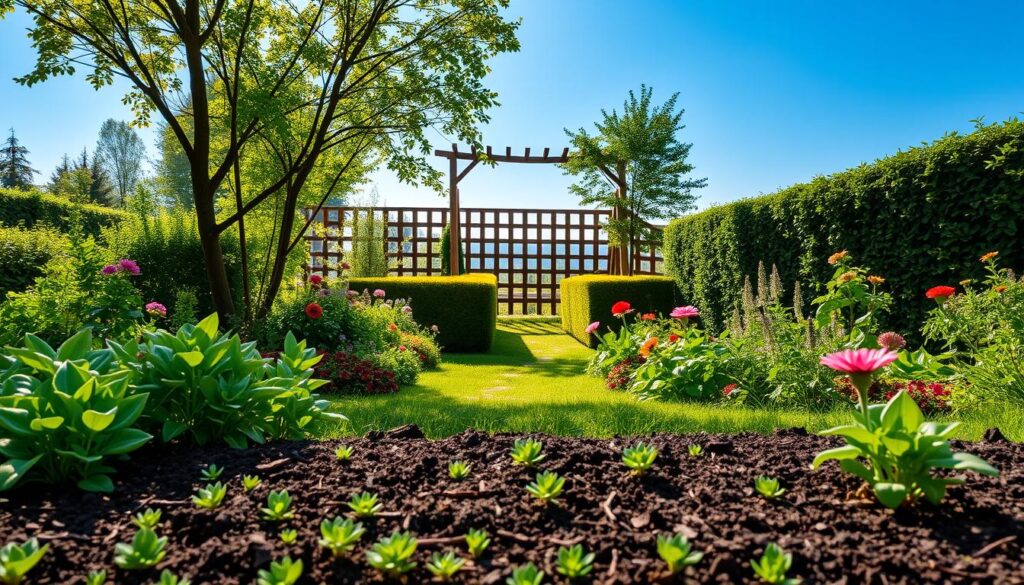
By carefully looking at these points and choosing the right garden location, you can have a beautiful garden that’s easy to take care of. Make sure to think about sunlight requirements and soil quality for your plants. With some planning, you can have a stunning garden that doesn’t need a lot of work.
| Garden Location | Sunlight Requirements | Soil Quality |
|---|---|---|
| Full sun | 6+ hours direct sunlight | Well-draining soil with pH 6.0-7.0 |
| Partial shade | 4-6 hours indirect sunlight | Moist soil with pH 6.0-7.0 |
| Full shade | 0-4 hours indirect sunlight | Rich soil with pH 6.0-7.0 |
Essential Tools and Equipment for Easy Gardening
Gardening can be rewarding but also time-consuming. The right tools and equipment make it easier and more efficient. New technology, like automated watering systems, reduces the effort needed to care for a garden.
Some key tools include gardening gloves, pruning shears, and irrigation timers. They save time and effort, making gardening more enjoyable. These tools also make gardening easier for people of all ages and abilities.
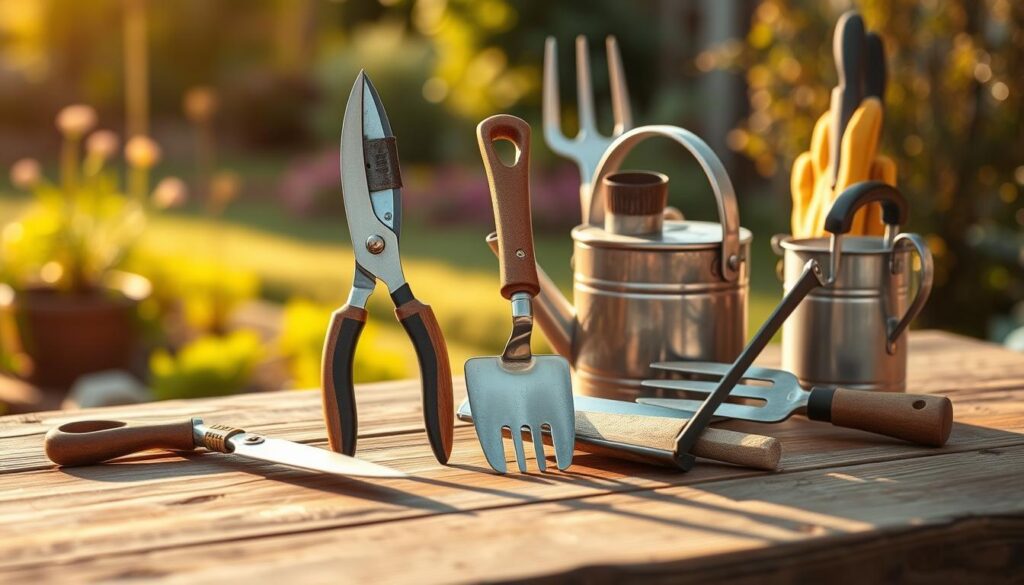
There are many labor-reducing tools out there. Self-propelled lawn mowers and automated garden cultivators are popular. They make tasks like mowing and weeding easier, so you can enjoy gardening more.
Here are some benefits of using gardening tools and equipment:
- Save time and effort
- Reduce physical demands
- Improve gardening efficiency
- Enhance overall gardening experience
Investing in the right tools and equipment makes gardening more enjoyable and sustainable. Whether you’re new to gardening or have been doing it for years, there are many options to help you succeed.
Best Low-Maintenance Plants for Busy Gardeners
Choosing the right plants is key for busy gardeners. They need plants that are easy to care for. Drought-resistant perennials, self-seeding annuals, and low-care shrubs and trees are perfect.
There are many low-maintenance plants to pick from. Succulents and sedums are great for dry areas. Marigolds and zinnias are easy to care for because they spread on their own.
Recommended Plants
- Succulents, such as aloe and agave
- Sedums, such as sedum spurium and sedum spectabile
- Marigolds and zinnias, which are self-seeding annuals
- Low-care shrubs, such as boxwood and holly
Adding these plants to your garden makes it beautiful with little work. Make sure to pick plants that fit your climate and soil. If you need help, ask a gardening expert.
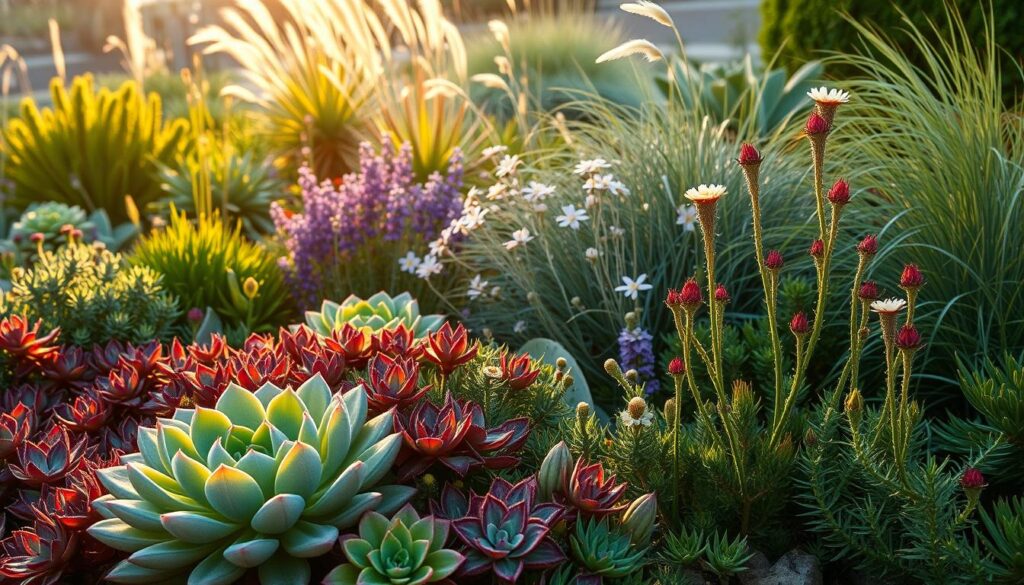
Smart Soil Preparation Techniques
Proper soil preparation is key for a low-maintenance garden. It cuts down on the need for fertilizers and pesticides. By spending time on soil prep, gardeners help their plants grow well. This is a core part of low-maintenance gardening.
It’s good for plants and the environment too. It means using fewer chemicals.
One great way to get the soil ready is through composting. It turns organic stuff into a soil booster. This natural method makes the soil better for plants and helps good bugs grow.
Adding compost to the soil makes a garden that needs less care. It’s a balanced place for plants to flourish.
Some perks of good soil prep include:
- Soil that’s better for plants
- Soil that holds water but also drains well
- Less need for fertilizers and pesticides
- Plants that are healthier and need less care
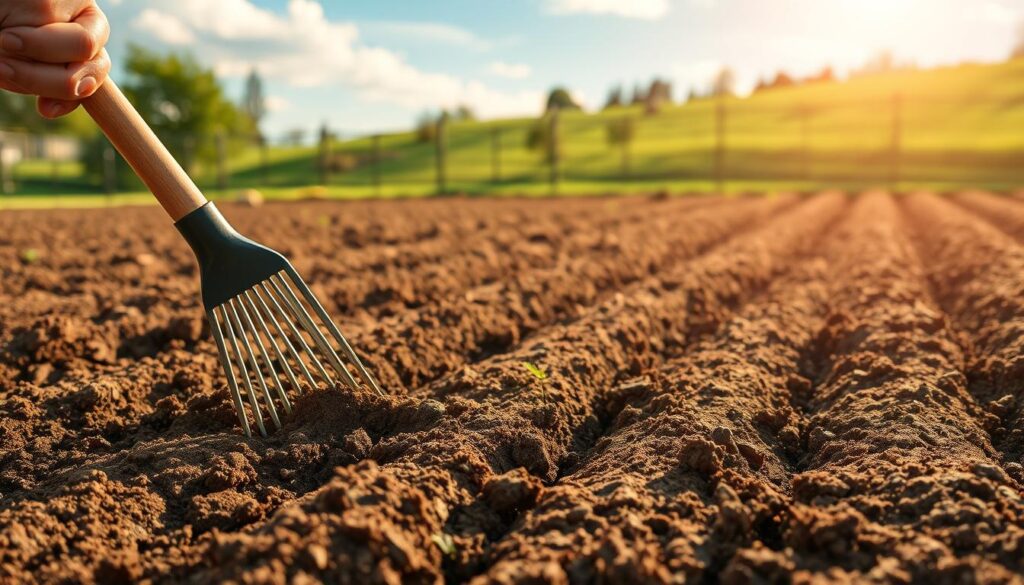
Using smart soil preparation like composting makes a garden that’s easy to care for. This is the heart of low-maintenance gardening. It’s all about planning and prep to avoid constant upkeep.
Efficient Watering Strategies
Keeping a garden healthy and thriving is all about efficient watering. By using smart watering methods, gardeners save time and water. This makes their garden easier to care for. Water conservation is key, using systems that waste less water.
Drip irrigation is a top choice for efficient watering. It sends water straight to the roots, cutting down on evaporation and runoff. This method saves water and prevents overwatering, which harms plants. Plus, efficient watering systems can be set to water automatically. This means gardeners can plan when their plants get watered.
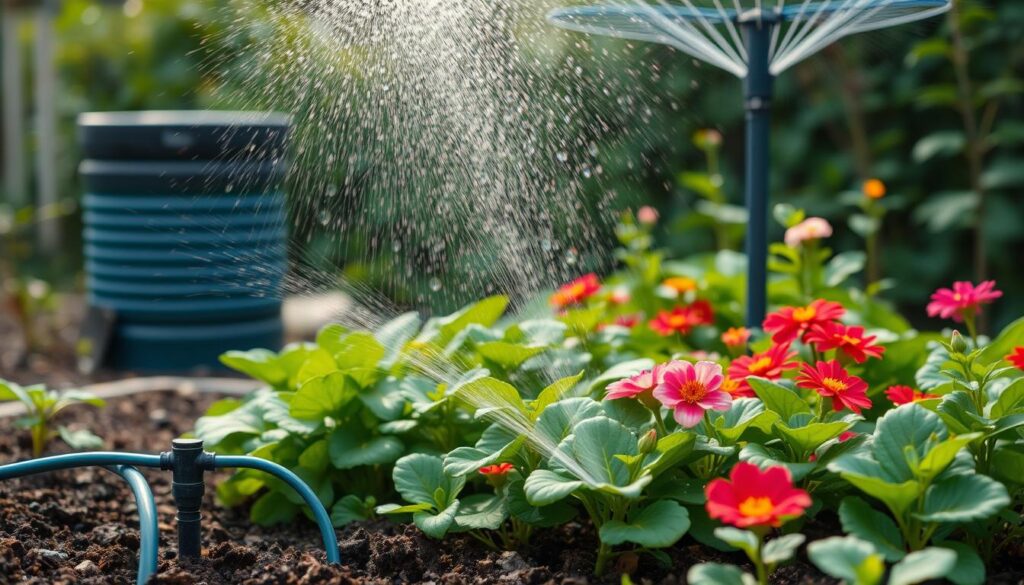
- Mulching to retain moisture in the soil
- Using rain barrels to collect and store rainwater
- Implementing a watering schedule based on weather conditions
By using these strategies, gardeners can make their gardens more sustainable and easy to care for. They also help the environment. As gardeners look for better ways to water, using efficient systems and saving water will grow more important.
Time-Saving Garden Design Ideas
A well-designed garden is both beautiful and easy to care for. Features like pathways and raised beds make upkeep simple. To make your garden stunning and easy to manage, add low-maintenance elements. Think about using drought-resistant plants and efficient watering systems in your garden design.
Some time-saving garden design ideas include:
- Using mulch to retain moisture and suppress weeds
- Implementing a drip irrigation system to conserve water
- Creating a low-maintenance landscape with native plants and grasses
A garden design with these elements saves you time on upkeep. This lets you enjoy your outdoor area without stress. By picking the right plants, materials, and features, you can have a time-saving and low-maintenance garden that looks great and works well.
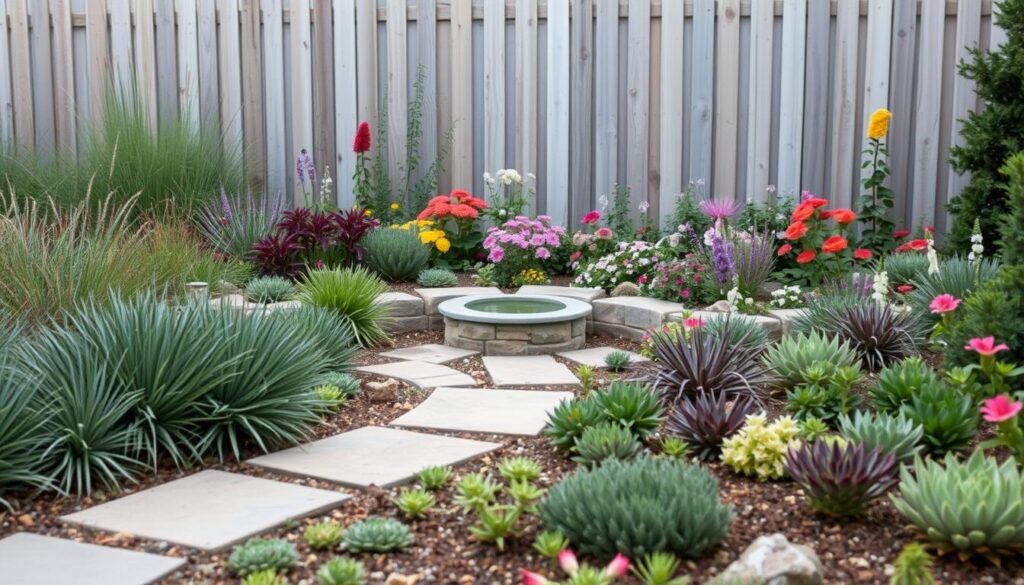
By using these time-saving garden design ideas, you can have a beautiful and low-maintenance garden. This garden needs little care, so you can relax and enjoy it more.
Natural Pest Control Solutions
Gardeners aim to create a balanced ecosystem. This promotes healthy plant growth and reduces chemical pesticide use. Natural pest control methods are as effective as chemicals but safer for the environment and health. Companion planting is a key approach, pairing plants that repel pests or attract beneficial insects.
For example, marigolds can be planted with tomatoes to keep nematodes away. Basil and lettuce together can fend off aphids.
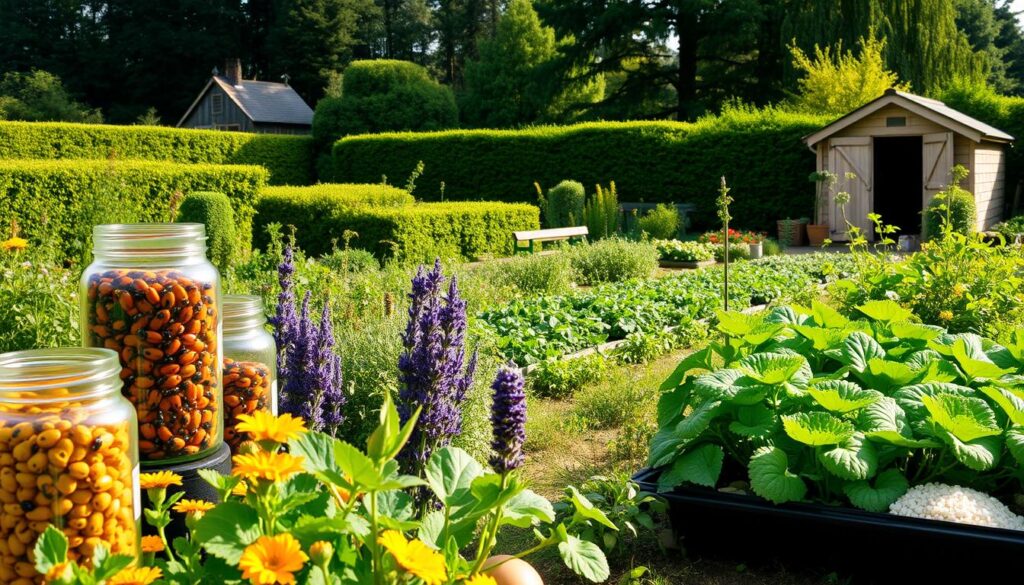
Beneficial insects like ladybugs and lacewings also help control pests. They eat common garden pests, reducing pesticide need.
Effective Companion Planting Strategies
- Planting marigolds with tomatoes to repel nematodes
- Planting basil with lettuce to repel aphids
- Planting dill with cucumbers to repel aphids and mites
Attracting Beneficial Insects
It’s important to welcome beneficial insects into your garden. Plant a variety of flowers that offer nectar and pollen, like sunflowers and zinnias. Using these natural methods helps gardeners avoid chemical pesticides. It makes for a healthier, more sustainable garden ecosystem.
Year-Round Maintenance Schedule
To keep your garden thriving, having a well-planned maintenance schedule is key. This schedule should include seasonal tasks for each time of the year. By following a year-round gardening plan, your garden will stay healthy and look great all year.
A good maintenance schedule includes tasks like pruning, watering, and fertilizing. These tasks should match your garden’s needs for each season. For instance, in spring, you’ll focus on pruning and planting. Summer is for watering and fertilizing.
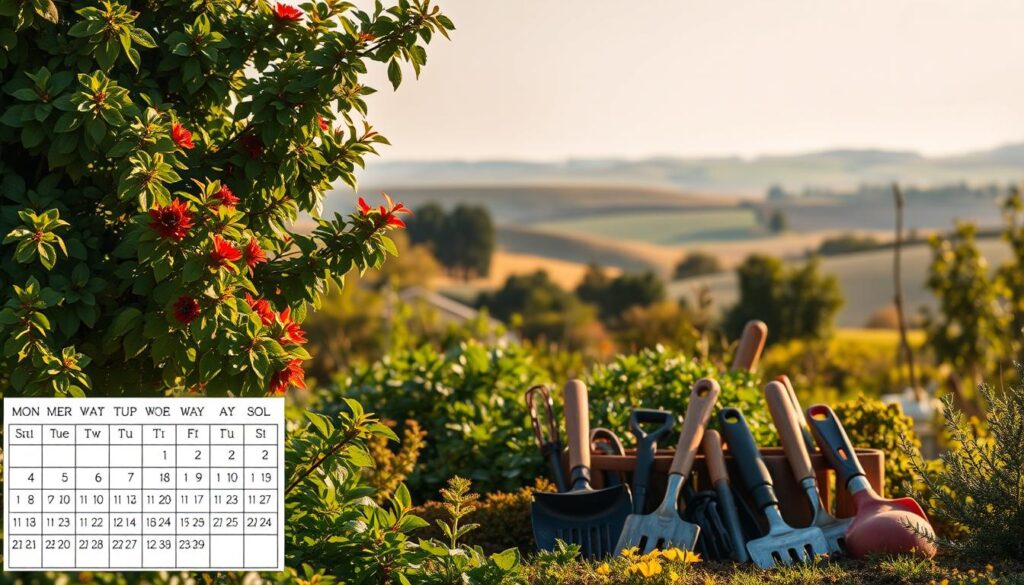
- Spring: Prune plants, plant new flowers and vegetables, and apply fertilizer
- Summer: Water plants regularly, deadhead flowers, and trim back overgrown plants
- Autumn: Harvest crops, clean up garden beds, and apply mulch
- Winter: Protect plants from frost, prune back dead branches, and plan for the upcoming gardening season
By following a year-round gardening plan and staying on top of seasonal tasks, you can enjoy a beautiful garden all year. Remember to review and adjust your maintenance schedule regularly to keep it effective for your garden.
Common Mistakes to Avoid in Low-Maintenance Gardening
Low-maintenance gardening saves time, money, and stress. It’s all about choosing the right plants. The right plants mean less care and more enjoyment.
Knowing common mistakes is key. These include bad plant choices, poor garden design, and not planning maintenance. By avoiding these, you can have a garden that’s easy to care for.
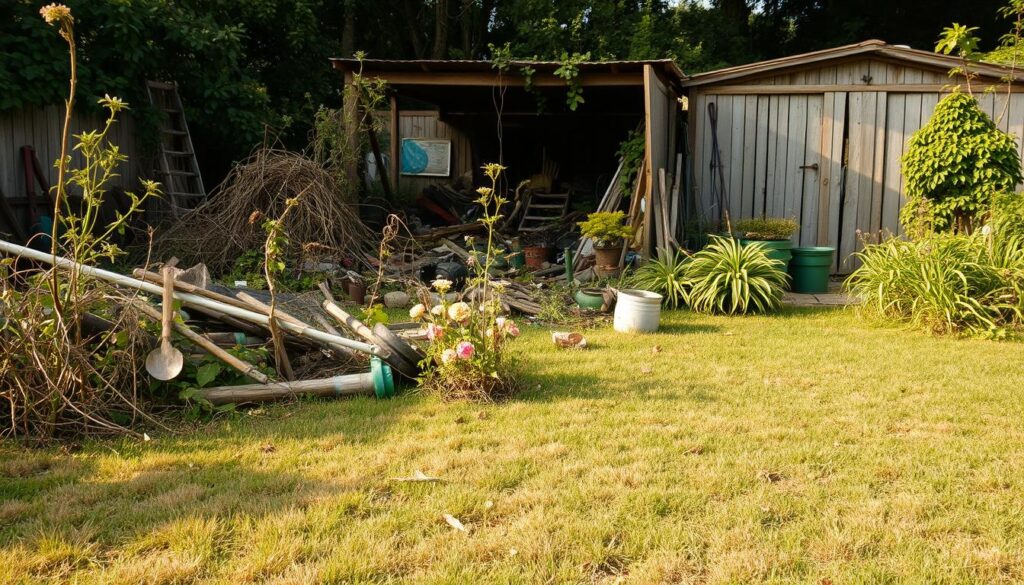
- Poor soil preparation can cause drainage and nutrient problems
- Not watering enough or too much can harm plants
- Not enough mulch leads to weeds and soil loss
Avoiding these mistakes helps you create a beautiful garden. It’s easy to care for and looks great. With the right plants and design, anyone can enjoy gardening without much work.
Conclusion: Creating Your Perfect Low-Effort Garden
Now that you’ve learned from this guide, you can turn your outdoor area into a beautiful, easy-to-care-for garden. The secret to a great garden is choosing the right plants, using smart gardening tips, and keeping up with a simple routine.
By following the low-maintenance gardening tips, you can have a green, beautiful space that’s easy to keep up. Enjoy the simple pleasure of outdoor living. Let your garden be a peaceful spot where you can relax and enjoy nature.
FAQ
What are the benefits of low-maintenance gardening?
Low-maintenance gardening saves time and reduces stress. It also boosts mental health. With smart planning and the right plants, you can have a beautiful garden with little upkeep.
What factors should I consider when choosing the location for my low-maintenance garden?
When picking a spot for your garden, think about sunlight, soil, and how easy it is to get to. The right location makes caring for your garden easier.
What are some of the best low-maintenance plants for busy gardeners?
Great plants for busy gardeners include drought-resistant perennials and self-seeding annuals. Also, low-care shrubs and trees are good choices. These plants need less care to thrive.
How can I implement efficient watering strategies in my low-maintenance garden?
To water your garden efficiently, use drip irrigation and mulch. These methods save time and water. They help your garden stay healthy with less effort.
What are some common mistakes to avoid when creating a low-maintenance garden?
Avoid mistakes like bad plant choices and poor design. Also, don’t forget to maintain your garden regularly. Researching plants and planning your garden well can prevent these errors.